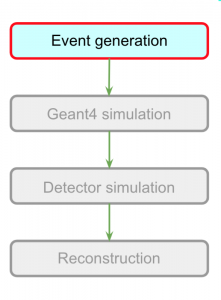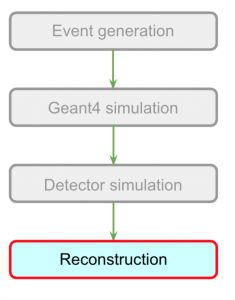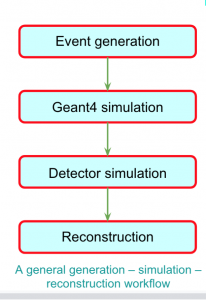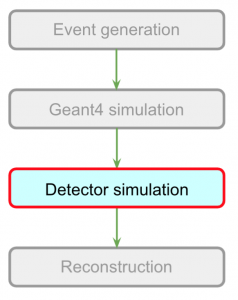LArSoft provides tools to carry out simulation, reconstruction and analysis of LArTPC data. Consider for instance, an event generation, detector simulation, reconstruction workflow as shown in the following figure:
Each piece will be described in more detail.
Event Generation
 For neutrino interactions, need a source of neutrinos. Event generation is the step that produces truth information about a particle that is either created in or traverses the detector. Those particles can be the result of neutrino interactions using something like Genie, so need an input source of neutrinos.
For neutrino interactions, need a source of neutrinos. Event generation is the step that produces truth information about a particle that is either created in or traverses the detector. Those particles can be the result of neutrino interactions using something like Genie, so need an input source of neutrinos.
Could be a fictitious source like SingleGen or outside like cosmic rays.
If the particles are a result of neutrino interactions, need models for neutrino interaction such as Genie. The input to Genie is a flux of neutrinos and the detector geometry. To get the flux of neutrinos, need something like Beam Simulation, which is outside LArSoft. (Note, all sources of neutrinos are outside LArSoft.)
Beam Simulation
- Generates neutrino flux hitting the detector
- Simulated sources can include accelerator, sun, astrophysical sources, KDAR sources, etc. (so not strictly from accelerator beams)
The beam simulation is external to LArSoft
There are multiple event generators available that are integrated into LArSoft in different ways.
- Genie: GENIEGen module
- Single particles: SingleGen module
- Cosmic ray generators: CORSIKA, CRY
Geant4 simulation
- Particle propagation simulation
- Models energy depositions and particle interactions in the detector
- Rich, configurable models of particle interactions, optical properties (including detailed index of refraction, reflectivity, etc.)
- Can perform optical simulation at single photon level
- The only simulation currently integrated with LArSoft (though can easily integrate others)
- Models energy depositions and particle interactions in the detector
Detector simulation
A separate workflow in itself
- Factorized into the following steps (implemented as separate modules / partly combined in WireCell)
- Ionization and scintillation light modeling from energy depositions
- Drift electron simulation
- Anode region simulation, signal induction and noise modeling, digitization
- Photon transport and detection model, including “S2 light” simulation for dual-phase detectors
- Optical signal induction, noise modeling and digitization
Basic particle physics combined with specific detector geometries.
- Majority are Geant4 based
- Generally these simulations are embedded into the experiment’s offline framework
- LArSoft uses art
Reconstruction
 Three major paradigms, each with its own variants, modules, workflows
Three major paradigms, each with its own variants, modules, workflows
- 2D clustering and view matching
- Image processing / deep learning techniques
- 3D imaging
For more information about any of these concepts, please see Erica Snider’s Introduction to LArSoft – source material.


